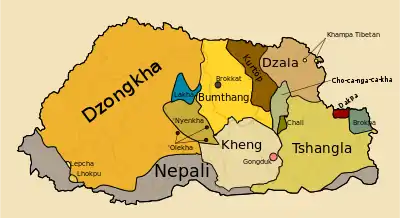East Bodish languages
The East Bodish languages are a small group of non-Tibetic Bodish languages spoken in eastern Bhutan and adjacent areas of Tibet and India. They include:
| East Bodish | |
|---|---|
| Ethnicity | Monpa people etc. |
| Geographic distribution | Bhutan |
| Linguistic classification | Sino-Tibetan
|
| Glottolog | east1469 |
George van Driem initially proposed that 'Ole belonged to the group, but later decided that it belonged to a group of its own.[1]
Although the East Bodish languages are closely related, Tshangla and related languages of eastern Bhutan, also called "Monpa" and predating Dzongkha, form a sister branch not to the East Bodish group, but to its parent Bodish branch.[2][3] Thus the ambiguous term "Monpa" risks separating languages that should be grouped together, whereas grouping languages together that are quite distinct.[4] Zakhring is apparently also related, though strongly influenced by Miju or a similar language.[5]
Internal classification

Hyslop (2010)[6] classifies the East Bodish languages as follows.
- East Bodish
She regards the Dakpa–Dzala and Bumthangic subgroups as secure, and the placement of Phobjip and Chali as more tentative.[7]
Lu (2002) divides the "Menba language" (门巴语) into the following subdivisions:[8]
- Southern: 30,000 speakers in Cona County, Lhoka (Shannan) Prefecture, Tibet
- Mama dialect 麻玛土语: Mama Township 麻玛乡 (or 麻麻乡), Lebu District 勒布区
- Dawang dialect 达旺土语: Dawang Township 达旺镇, Mendawang District 门达旺地区
- Northern: 5,000 speakers in Mêdog County, Nyingchi Prefecture, Tibet
- Wenlang dialect 文浪土语: Wenlang Township 文浪乡, Dexing District 德兴区
- Banjin dialect 邦金土语: Bangjin District 邦金地区
Reconstruction
Hyslop (2014)[9] reconstructs the following Proto-East Bodish forms.
- *kwa ‘tooth’
- *kra ‘hair’
- *kak ‘blood’
- *kʰrat ‘waist’
- *lak ‘hand’
- *ná ‘nose’
- *pOskOm (?) ‘knee’
- *rOs ‘bone’
- *gO- ‘head’
- *mE- ‘eye’
- *kram ‘otter’
- *ta ‘horse’
- *kʰa- ‘hen’
- *wam ‘bear’
- *kʰwi ‘dog’
- *kʰaça ‘deer’
- *zV ‘eat’
- *ra ‘come’
- *gal ‘go’
- *lok ‘pour’
- *dot ‘sleep’
- *bi ‘give’
- *kʰar ‘white’
- *mla ‘arrow’
- *gor ‘stone’
- *kʰwe/*tsʰi ‘water’
- *rO (?) ‘wind’
- *On (?) ‘baby’
- *daŋ ‘yesterday’
- *néŋ ‘year’
- *da- ‘today’
- *tʰek ‘one’
- *sum ‘three’
- *ble ‘four’
- *laŋa ‘five’
- *grok ‘six’
- *nís ‘seven’
- *gʲat ‘eight’
- *dOgO ‘nine’
- *kʰal(tʰek) ‘twenty’
- *ŋa ‘1.SG’
- *i/*nVn ‘2.SG’
- *kʰi/*ba ‘3.SG’
- *-ma ‘FUT’
- *lo ‘Q.COP’
Additional reconstructions can be found in Hyslop (2016).[10]
References
- van Driem, George (2011). "Tibeto-Burman subgroups and historical grammar". Himalayan Linguistics Journal. 10 (1): 31–39.
- van Driem, George L. (1994). "Language Policy in Bhutan" (PDF). Bhutan: aspects of culture and development. Kiscadale. pp. 87–105. ISBN 978-1-87083-817-7.
- van Driem, George (2001). Languages of the Himalayas: An Ethnolinguistic Handbook of the Greater Himalayan Region. Brill. p. 915. ISBN 978-90-04-12062-4.
- Andvik, Eric E. (2009). A Grammar of Tshangla. Tibetan Studies Library. 10. Brill. pp. 4–7. ISBN 978-90-04-17827-4.
- Blench, Roger; Post, Mark (2011), (De)classifying Arunachal languages: Reconstructing the evidence (PDF), archived from the original (PDF) on 2013-05-26
- Hyslop, Gwendolyn. 2010. On the internal phylogeny of East Bodish. Paper presented at the 5th NEILS meeting, Gauhati University 12–14 February 2010.
- Hyslop, Gwendolyn (2013). "On the internal phylogeny of East Bodish". In Hyslop, Gwendolyn; Morey, Stephen; Post, Mark W. (eds.). North East Indian Linguistics. 5. New Delhi: Cambridge University Press India. pp. 91–112. ISBN 978-93-82264-72-9.
- Lu, Shaozun 陆绍尊 (2002). 门巴语方言研究 [A study of Menba (Monpa) dialects] (in Chinese). Beijing: Ethnic Publishing House 民族出版社.
- Hyslop, Gwendolyn (2014). "A preliminary reconstruction of East Bodish". In Owen-Smith, Thomas; Hill, Nathan W. (eds.). Trans-Himalayan Linguistics: Historical and Descriptive Linguistics of the Himalayan Area. Berlin: Mouton de Gruyter. pp. 155–179. ISBN 978-3-11-031074-0.
- Hyslop, Gwendolyn. 2016. East Bodish reconstructions in a comparative light. Fourth Workshop on Sino-Tibetan Languages of Southwest China (STLS-2016). University of Washington, Seattle, September 8–10, 2016.
- Hyslop, Gwendolyn (2014). "A preliminary reconstruction of East Bodish". In Owen-Smith, Thomas; Hill, Nathan W. (eds.). Trans-Himalayan Linguistics: Historical and Descriptive Linguistics of the Himalayan Area. Berlin: Mouton de Gruyter. pp. 155–179. ISBN 978-3-11-031074-0.